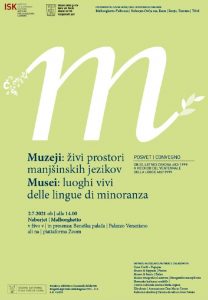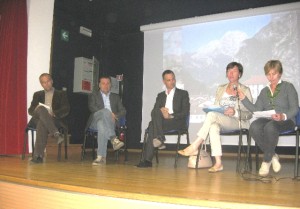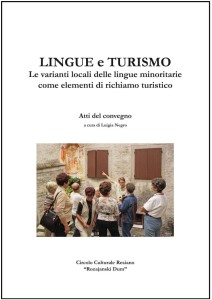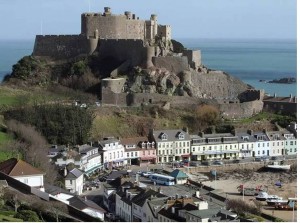Regione Friuli Venezia Giulia
Malborghetto, 2 luglio 2021. Convegno sul tema “Muzej živi prostori manjšinskih jezikov/Musei: luoghi vivi delle lingue di minoranza ” a cura dell’Istituto per la cultura slovena di San Pietro al Natisone/Inštitut za slovensko kulturo e del Museo della gente della Val Resia/Muzej rezijanskih ljudi.
Plakat posveta volantino convegno 02.07.2021
Tolmezzo, 20 giugno 2015. Primo incontro degli operatori culturali delle minoranze linguistiche della Regione Friuli Venezia Giulia con l’assessore regionale alla cultura, Gianni Torrenti.
Il multilinguismo e la valorizzazione delle specifiche realtà linguistiche, culturali e storiche caratterizzano e quindi arricchiscono l’offerta turistica del Friuli Venezia Giulia”. Lo ha affermato l’assessore regionale alla Cultura, Gianni Torrenti, oggi a Tolmezzo (Ud) all’incontro “Lingue di minoranza e turismo” con i rappresentanti dei circoli culturali germanofoni di Timau e Sauris e le associazioni delle comunità slovena della provincia di Udine. All’incontro sono state presentate le valide esperienze di turismo linguistico maturate nel corso degli anni in Val Canale, Val Resia, Carnia e nella Benecia: è rilevante il numero dei turisti sloveni e di lingua tedesca che visitano ogni anno il Friuli Venezia Giulia per conoscere i dialetti, le tradizioni e le identità delle minoranze linguistiche. Questo tipo di turismo cresce anche altrove in Italia, soprattutto in Calabria (grecanici) e ad Alghero in Sardegna (catalani). Le buone prassi di questo specifico settore sono state illustrate al convegno “Lingue e turismo. Le varianti locali delle lingue minoritarie come elementi di richiamo turistico”, che si è tenuto nel 2008 in Val Resia. L’offerta turistica, definita di nicchia, ha una ricaduta economica sul territorio e valorizza la lingua e la cultura locali. “Come Regione siamo convinti – ha spiegato l’assessore Torrenti – che l’offerta turistica del Friuli Venezia Giulia debba essere il più possibile caratterizzata per differenziarsi dalle altre: è necessario quindi migliorare con contenuti identitari le singole proposte per essere più attrattivi”. “In tal senso – ha aggiunto l’assessore – credo che il plurilinguismo non possa essere scisso nell’immaginario dalla valorizzazione ambientale e dall’offerta enogastronomica di una determinata realtà geografica”. Questa prospettiva di sviluppo fermerebbe d’altronde il fenomeno dell’emigrazione dalla montagna friulana, “che la Giunta regionale è determinata a fermare, attuando gli investimenti”. Le associazioni hanno parlato con l’assessore Torrenti anche della possibilità di istituire specifiche specializzazioni per guide turistiche, le quali potrebbero così esercitare meglio la propria professione nei territori caratterizzati dalla presenza delle minoranze. All’incontro è stato proposto di sviluppare specifiche forme di collaborazione transfrontaliera per offrire pacchetti turistici e marketing territoriale. Per Marco Stolfo (ARLeF, Università degli Studi di Udine) è necessario sviluppare maggiormente nelle menzionate aree il plurilinguismo visivo (“specialità nella normalità”) e pubblicizzare simili iniziative (festival del cinema nelle lingue minoritarie) che contribuiscono a rendere più attrattivi i territori. Velia Plozner del circolo “Unfer” di Timau ha richiamato l’attenzione sulle possibilità di sviluppo del turismo linguistico nell’ambito del Comitato unitario delle isole germanofone in Italia, che sta riflettendo sulla creazione di un marchio unitario per i prodotti locali. La riforma regionale delle Autonomie locali può rappresentare un’opportunità per diffondere sul territorio simili progetti, ha ricordato Torrenti, aggiungendo come “simili iniziative di sviluppo della ricchezza linguistica si possono ricercare anche all’interno della nuova strategia della Macroregione alpina”. Hanno partecipato alla riunione anche Lucia Protto (“F. Schneider” di Sauris), Marina Cernetig (Istituto per la cultura slovena – S. Pietro al Natisone), Luisa Cher (Centro ricerche culturali Lusevera), Luciano Lister (“Don Mario Cernet” – Val Canale) e Luigia Negro (“Rozajanski dum” – Resia). ARC/MCH (tratto dal sito della Regione FVG)
Udine, 15 aprile 2015. Nella biblioteca civica Joppi presentazione degli atti del convegno Lingue e Turismo. Le varianti locali delle lingue minoritarie come elementi di richiamo turistico.
4 ottobre 2014 -Timau (Paluzza – Udine). Presentazione degli atti del convegno “Lingue e Turismo. Le varianti locali delle lingue minoritarie come elementi di richiamo turistico”.
(da sinistra: Marco Stolfo, Università di Udine, Enzo Marsilio, Consiglio Regionale del Friuli Venezia Giulia, Massimo Mentil, sindaco Comune di Paluzza, Luigia Negro, Circolo Culturale Resiano “Rozajanski Dum”, Velia Plozner Circolo Culturale “G. Unfer” di Timau)
Atti del convegno Lingue e Turismo. Le varianti locali delle lingue minoritarie come elementi di richiamo turistico
29 maggio 2014 – Udine. Convegno “Le collezioni uniscono / Zbirke povezujejo. Collezioni etnologiche, tradizione orale e turismo culturale fra le Alpi e il Carso. / Etnološke zbirke, ustno izročilo in kulturni turizem med Alpami in Krasom” organizzato nell’ambito del progetto europeo Italia – Slovenija “Zborzbirk Kulturna dediščina v zbirkah med Alpami in Krasom / L’eredità culturale nelle collezioni fra Alpi e Carso”. Atti.
26 settembre 2008 – Resia. Convegno sul tema “Lingue e Turismo. Le varianti locali delle lingue minoritarie come elementi di richiamo turistico”. Organizzato dal Circolo Culturale Resiano “Rozajanski Dum”.
Veneto
Canazei (Trento) 9-11 settembre 2016.
Convegno “Identità linguistica e turismo”. Org. Istitut Cultural Ladin.
Programma_Griki_Italiano.1472479902
Dal Consiglio d’Europa
LE CONGRÈS DES POUVOIRS LOCAUX ET RÉGIONAUX
Résolution 301 (2010)1 Les langues minoritaires: un atout pour le développement régional
1. Les minorités linguistiques sont un atout pour le développement économique et culturel d’une région. Elles représentent un potentiel énorme et souvent négligé.
S’il est convenablement valorisé, ce potentiel peut stimuler les activités culturelles et économiques et contribuer fortement à la prospérité d’une région.
2. La plupart des locuteurs des langues régionales ou minoritaires sont multilingues. Toutes les études montrent que les locuteurs multilingues ont des performances supérieures à celles de leurs homologues monolingues. Cela tient à la fois aux compétences cognitives liées à l’apprentissage des langues et au fait que les connaissances linguistiques sont de plus en plus recherchées dans de nombreux secteurs.
3. Les régions frontalières d’Europe comptent de nombreuses minorités linguistiques. Celles-ci sont souvent la clé du développement de la coopération transfrontalière, qui est un aspect important de l’intégration européenne. Les régions qui ont favorisé l’utilisation des langues minoritaires
sur leur territoire en ont tiré un bénéfice en termes de croissance, pour elles-mêmes ou pour les régions voisines.
4. Les régions d’Europe doivent prendre conscience de la valeur ajoutée que les langues régionales ou minoritaires représentent. Elles peuvent contribuer de manière significative au tourisme culturel et aux activités liées au patrimoine.
5. La langue est un aspect essentiel de l’identité culturelle. Elle est au centre de la mémoire collective de la population et c’est par elle que se transmettent des identités culturelles complexes. Les minorités linguistiques dont la langue est pleinement reconnue et qui peuvent l’utiliser dans la sphère publique comme dans l’espace privé acquièrent une confiance en elles-mêmes qui se répercute sur leur activité
économique et leur créativité culturelle.
6. La Convention-cadre du Conseil de l’Europe pour la protection des minorités nationales (STE no 157) et la Charte européenne des langues régionales ou minoritaires (STE no 148) sont des instruments extrêmement utiles pour protéger et soutenir les populations minoritaires d’Europe ainsi que leurs langues, et elles mériteraient d’être mieux connues et d’être appliquées de manière systématique.
7. La vigueur des langues d’une région est un indicateur essentiel de son développement culturel et de sa vitalité. Le fait de donner aux langues de tous les groupes minoritaires un statut, une reconnaissance et un soutien appropriés est le signe d’une démocratie parvenue à maturité.
8. Compte tenu de ce qui précède, le Congrès invite les pouvoirs locaux et régionaux: a. à veiller à ce que les régions aient des politiques linguistiques assurant une protection et une promotion adéquates des langues autochtones qui y sont présentes; b. à encourager une plus grande utilisation des langues régionales ou minoritaires dans l’éducation, l’administration, les médias, l’économie et la vie sociale;
c. à encourager la maîtrise des langues régionales ou minoritaires dans la function publique;
d. à fournir un financement adéquat pour garantir l’offre d’un enseignement des
langues régionales ou minoritaires à partir de l’école maternelle;
e. à encourager l’éducation plurilingue combinant l’enseignement dans une langue nationale et l’enseignement dans une langue régionale ou minoritaire;
f. à soutenir l’usage des langues régionales ou minoritaires dans les médias locaux et régionaux et dans la vie économique et sociale;
g. à promouvoir les langues régionales ou minoritaires au moyen d’un vaste éventail d’activités culturelles, telles que des représentations théâtrales, des expositions, des manifestations littéraires et des concours de chansons;
h. à encourager et promouvoir les accords transfrontaliers relatifs à l’enseignement des langues et aux échanges éducatifs et culturels, en vue de développer la coopération économique transfrontalière.
1 Discussion et approbation par la Chambre des régions le 18 mars 2010 et adoption par le Congrès le 19 mars 2010, 3e séance (voir document CPR(18)3, exposé des motifs), rapporteurs: K.-H. Lambertz (Belgique, R, SOC) et F. Mukhametshin (Fédération de Russie, R, GILD).
Dal Canada
Tourism and Official Language Minority Communities (OLMC) – Final Report for Industry Canada. Conclusion
As we have attempted to show, the Canadian tourism industry in minority communities faces a range of issues to which particular attention was drawn in our interviews with businesspeople and community stakeholders working in tourism or with a particular interest in tourism.
Some of our recommendations, as you will have noticed, are of concern not only to federal players, but also to government stakeholders at the provincial and territorial level. Some also concern municipalities.
We believe that these recommendations will contribute to Industry Canada’s and the federal regional development agencies’ reflection on developing the tourist industry in minority communities as part of the follow-up on the Roadmap for Canada’s Linguistic Duality 2008–2013. However, because of the limitations described, we reiterate that research and consultation should be continued so that the issues that are common to all communities can be studied and solutions be proposed. Region-specific issues could also be explored in greater depth.
Lastly, we would like to emphasize that, in our opinion, for the tourism industry to develop within minority communities, greater “recognition” and “knowledge” of this sector are priorities (Issues 1 and 2). Government players and the private sector must, with the help of exhaustive research and data on tourism in minority communities, actually become aware of the potential of tourism in minority communities in order to be encouraged to invest in it for the benefit of these communities and the Canadian economy as a whole.
Dal Regno Unito
Four British languages in danger of becoming extinct
Jersey French, Guernsey French, Manx language and Cornish all feature on an new ‘endangered’ list
Tourists looking for sun and sea but keen for something extra from their holiday break can now help save an ancient language.
Four languages spoken on British territories feature on an new “endangered” list, with the numbers of people using them seriously dwindling. There are particular fears for the future of Jersey French and Guernsey French, which are marked as “severely endangered” on a list of 33 under-threat languages.
The at-risk list was compiled by the language expert Christopher Moseley at the UCL School of Slavonic and East European Studies and is based on data from the Unesco Languages in Danger project which was launched in 1993.
A new report, which highlights the threatened languages, believes “linguistic tourism” can help save them by stimulating greater interest in learning them and helping them survive, if not thrive. Naren Shaam, the chief executive of GoEuro, said the travel planning company wanted to promote a new “linguistic-based” ethical tourism “allowing people to choose to directly benefit regions in which centuries-old languages are on the cusp of extinction”.
Tony Scott Warren, the Jersey French language officer known as Offici du l’Jèrriais, said: “It is a worry. We’re making efforts to educate as many people as possible. It’s not surprising we are on the list. The numbers have been declining for a long time.” He estimates that about 1,000 native speakers remain. “We are looking to develop the range of what we’re doing to get more people involved,” he said.
While the Isle of Man’s Manx language and Cornish were categorised in the more severe “critically endangered” category, experts believe the future is brighter for both.
Dr Moseley said: “It was an uphill battle because Manx had reached the point where the last first-language speaker died in 1974. Since then they’ve been running classes and they have a school. Both that and Cornish are being revived in an organised way. Education is the most important thing.” He added that in the next decades there could be first-language Manx speakers born. “There has been an increasing move toward regional identity and against the homogenisation of Britain. I think that’s all to the good.”
Adrian Cain, the language officer for the Isle of Man, said: “The language situation is significantly better than 20 or 30 years ago. There’s always been a strong sense of identity and in the 1980s resources were put into supporting the language. There has long been a groundswell of support from the people. It’s great. It differentiates us and generates a positive feel.” He said officials from around the world backing other minority languages often visited to find out how the Isle of Man had revitalised Manx.
Dr Moseley identified 13 critically endangered languages and a further 20 that are severely endangered.
The most at risk is Livonian, from the Latvian region of Dundaga. Livonian is spoken in a medieval town with a population of just 1,682. The last first-language speaker of the language, Grizelda Kristina, who fled Latvia in 1944, died last year at the age of 103.
Other languages that face extinction include Ter Sami, the most easterly dialect spoken by Laplanders. Gottscheerisch, which originated in Slovenia, is still spoken by a small community in the Queens district of New York. (Tratto dal quotidiano The Independent del 9.11.2014)
Dalla Puglia
‘Le Lingue Minoritarie in Puglia’. Francoprovenzale, arbëreshë, grecìa salentina. Tutte minoranze linguistiche tutelate dalla Legge 482 del 1999. Una Legge che attraverso l´attivazione degli Sportelli Linguistici punta a preservare, promuovere e valorizzare lo sviluppo di queste comunità storico-linguistiche. Anche dal punto di vista turistico, artistico e culturale con la riscoperta dei territori, delle tradizioni antiche, degli itinerari, dei monumenti, delle festività, delle usanze e delle gastronomie tipiche. Di qui, l´idea di realizzare nell´ambito del progetto di tutela delle Minoranze Linguistiche Storiche finanziato dalla Regione Puglia: ‘Minoranze Linguistiche in Puglia: la Guida Turistica e Culturale’.
Un volume a colori di 138 pagine ricco di fotografie, cenni storici e geografici, informazioni e numeri utili che ha l´obiettivo di esaltare “la ricchezza storica, paesaggistica ed enogastronomica dei luoghi scelti come insediamento, in tempi remoti, dalle comunità di minoranza linguistica”. La guida, dunque, è nata grazie all´intesa siglata tra le Amministrazioni Provinciali di Foggia e Taranto e l´Unione dei Comuni della Grecìa Salentina, con la consulenza editoriale di Euromediterranea Pianificazione %26 Sviluppo.
Dalla Spagna
Language, Identity and Tourism in Minority Contexts
Joan Pujolar, Universitat Oberta de Catalunya, Spain
WS129: Language as social practice in the globalized new economy
In this paper, I shall analyze and compare the position and signification of languages in contemporary tourist activities in three linguistic minority contexts: Catalonia, Wales and (Francophone) Ontario. Languages have not been traditionally treated as an attraction or as having added value in tourist markets, except with respect to the multilingualism required in tourist services. However, during the last 15 years, the rise of cultural tourism has led to the articulation of products where language is constructed as an asset associated with the territory and the artistic and cultural heritage of destinations.
My approach focuses on the new scenarios and discourses on language brought about by globalization. I consider tourism to be a sector of activity where the chances and challenges of globalization become particularly visible. With respect to language, globalization transforms the ways in which industrial societies had managed linguistic diversity and language more generally. The modern paradigm constructed language as an ‘internal element’ that contributed to define the national community and to legitimicize state sovereignty through standardization and linguistic uniformization. Globalization decenters or disarticulates local and national social spaces, imposes multilingualism and diversity and forces linguistic communities to consider the projection of their languages ‘externally’. These processes affect both large and small communities. These transformations trigger changes in the discourses over languages and often lead to contradictions with the traditional identity values. They require social groups to reformulate their political and economic strategies in relation to language and they potentially involve a marketization of identities within global markets.
The data will consist of ethnographic observation, in-depth interviews of actors implicated in tourist and language policies, official documents and web-sites. I shall analyze the role attributed to languages in the tourist portfolios of these destinations, as well as the effective presence of local languages in tourist services as evidence that reveals struggles and contradictions between competing linguistic ideologies furthered by different social groups.
Dal Trentino
International Conference on Language, Economy and Tourism
Soraga (Trento) 8 giugno 2017
Tourism can provide unlimited opportunities for economic development and can become an important source of income and employment. It can also provide local communities with the opportunity to express pride in their own culture and language, reviving their traditions, cultural practices and becoming a window to the world. Tourism enables interaction between individuals of different nationalities and backgrounds, thus fostering dialogue among cultures and encouraging cultural diversity and creativity, as proclaimed by UNESCO. At the same time, the increasing human mobility and globalization can foster an increasing homogenization of cultural and linguistic practices, a fact that has become a source of concern for most of regional and minority languages, which see how hegemonic languages, namely English, are replacing the small language communities.
The NPLD, in collaboration with Province of Trento, the Region Trentino-Alto Adige and the Tourism Office of Fassa Valley are organizing the International Conference on Language, Economy and Tourism, which will take place on June 8 in the municipality of Soraga at the Fassa Valley. Participants from different regional governments, institutions and associations across Europe will discuss about the challenges and the impact of tourism on the regional languages. The Conference will count on the participation of the head of the Secretariat of the Charter for Regional or Minority Languages of the Council of Europe, Mr. Sixto Molina, as well as representatives from renowned institutions such as the Bilbao Guggenheim Museum or the 2018 Leeuwarden Capital of Culture, among others.
The final programme is available here.




